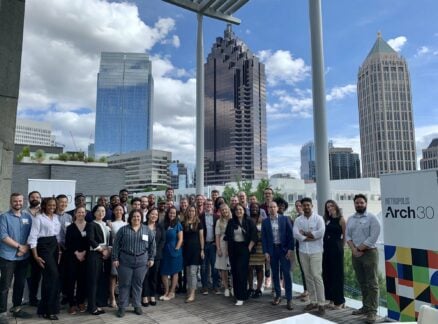June 1, 2010
Broadway Opening
After years of living in the shadow of its acclaimed academic neighbor, Barnard College steps out into the spotlight with a glittering new student center.
Nine years ago, Barnard College was in the midst of an identity crisis. The problem: it didn’t have one. Long in the shadow of Columbia University, just across Broadway in Manhattan’s Morningside Heights, the women’s college now found itself a prisoner of its own hulking student center. McIntosh Center, designed by Vincent Kling in 1969, along with a neighboring 14-floor science tower, not only barricaded the school from the street with a two-story concrete wall; it choked off life on all other sides too, disrupting any sense that the slender campus was more than a hodgepodge of dimly connected buildings. To add insult to injury, McIntosh didn’t even offer much space in exchange for its heavy footprint, and student life was leaking across the street. The first time Judith Shapiro, Barnard’s former president, saw the building, she remembers saying, “What were they thinking? It looks like a cigar humidor.”
To stitch its beleaguered grounds back together, the school turned to Weiss/Manfredi Architects, a New York–based firm whose work willfully confuses architecture and landscape. Its best-known project to date is the Olympic Sculpture Park, in Seattle, which remade a forlorn parcel of industrial waterfront into the city’s eighth-most-visited attraction (ahead of the Frank Gehry–designed Experience Music Project and just behind the Seattle Seahawks). Using the simple form of a Z as connective tissue, it reattached the brownfield site, which had been marooned by a four-lane highway, to its Belltown neighborhood. Though the park is more than a built-up lawn, it isn’t full-blown architecture either. Barnard, a tiny urban campus, is a very different site, but there was a similar need for what the architects call “chameleon agendas”: playing the building off the site, and the site off the building. “The traditional campus has often been defined by quads and courtyards, with views all the way across that give an identity and an address for all the buildings on that green,” Marion Weiss says. “The sense of knowing where you are on that campus is tied to a landscape that holds it together.” With a few shrewd gestures, Weiss/Manfredi’s new $70 million, 100,000-square-foot building, the Diana Center, reinvents Barnard, giving a small college’s even smaller campus some room to breathe.
The husband-and-wife team of Marion Weiss and Michael Manfredi have been working together for 21 years. They’re both architecture professors, and they sometimes speak as though they’ve just emerged from a graduate seminar. “Colors” become “chroma,” and they have “preoccupations” instead of “interests.” Manfredi describes their office of 25, in Manhattan’s Garment District, as “a studio, not a corporate office.” Still, the firm was short-listed this spring for a major competition to reframe the St. Louis Gateway Arch, which has only sharpened the architects’ sense of their own size. They’re up against Behnisch Architekten, Michael Van Valkenburgh, Peter Walker and Norman Foster, and SOM. “It’s a cast of big teams,” Manfredi says. Weiss says, “We’re the small and mighty team.”
In their office, a few of Weiss’s early, palm-sized paper models of the Diana hang on the wall, narrowing forms that anticipate the building’s final shape. “This was the first question,” Weiss says. “How do we connect? How do we taper? And how do we reveal?” She then points to a few muddled mock-ups produced soon after the first elegant paper cuts. “This is where we faced the music of the multiple floors,” she says. “Look how awful they are. The minute you start packing in all the program, it immediately falls apart.” Though Weiss and Manfredi are exceptionally good at smoothing the messy connections of a site, they don’t pretend their inspiration is divine. In Roman myth, Diana was the goddess of childbirth, and appropriately enough, her namesake building had its share of birthing pains.
The first task—the “taper” of Weiss’s model—was untangling the campus’s internal connections. Apart from closing off the school from Broadway, McIntosh’s bulk had separated Barnard’s historic northern end from its central outdoor space, Lehman Lawn. The Kling buildings also added a mountain of steps that ended in an elevated plaza, so Milbank Hall, the college’s first building, sat invisibly in a pit. “From the interior of the campus, you didn’t have a sense of what was going on,” says Lisa Gamsu, the college’s vice president for administration and capital planning. Instead of replicating McIntosh’s rectangular footprint, Weiss and Manfredi designed a wedge that tapers from 70 feet in the north to a slender, 45-foot-long southern face. Combined with a set of gently descending terraces that replace the isolating stairs, the wedge visually links the entire length of the campus. It’s the first time since Barnard moved to Morningside Heights in 1897 that one is able to see from the entry gate at West 117th Street to Milbank three blocks north.
With the shape of the building in mind, the architects still had to juggle a maddening variety of programs dispersed throughout seven narrow floors, while avoiding “the sorts of social separations that inevitably occur in vertically stacked buildings,” Weiss says. Barnard didn’t have the luxury of space. It had to fit its art and architecture departments, a black-box theater, an event space, dining facilities, and assorted classrooms, meeting rooms, faculty offices, and lounges into the Diana (which was named after Diana Vagelos, the Barnard alumna and trustee who, with her husband, Roy Vagelos, the former head of Merck, gave $15 million for the building). “One of the good things about having only a four-acre campus is that the buildings you build are not highly specialized,” Shapiro says. Weiss/Manfredi’s Robin Hood Foundation library at P.S. 42, in Queens, had already impressed Barnard’s trustees with the firm’s ability to design judiciously on a small scale. But at Barnard, the jumble of programs could have made for an intriguing mix or a confusing mess.
To connect the main levels—the second demand of the paper model—the architects made what Weiss calls “a landscape-scale move”: cutting a diagonal void of cascading atria into the building’s form. Since the stepped, glassed-in spaces are linked, students reading Adorno in the study room won’t feel cloistered from the café below, or Lehman Lawn beyond. “Big atriums are the empty spaces of the world,” Weiss says. “Nobody wants to be in them. So this whole idea of taking some of the generous spatial characteristics that an atrium has and packing it full of program and slipping it diagonally through a building gives you a totally different effect.”
With all that carefully orchestrated activity, it would have beeen a shame not to reveal it to the world—the final aim of the model. “Once we developed that general strategy to encourage different disciplines to see each other, different students to see different faculty members,” Manfredi says, “then it was just a question of wanting to mark that on the facade in a subtle way.” In place of the concrete wall on Broadway, the Diana’s facade reveals slices of the building through soft, nonreflective glass and hides others behind color-shifting bands. Playing to Barnard’s brick and terra-cotta and Columbia’s McKim, Mead and White neoclassicism, the glass and copper-anodized-aluminum panels link the Diana to its surrounding historic (and not so historic) buildings without aping them. “We tried to get a material that related chromatically but had its own chameleonlike quality,” Manfredi says. The muted-orange acid-etched glass, set five inches in front of back pans that are painted a vibrant red, is the first use of the material on a facade in the United States. It took a year of modeling, prototyping, and testing to get it right. Even then, the architects don’t know how the double-glass wall will look any given morning. The shade depends on the time of day and the weather: a passing cloud might coax an iridescent shimmer, and the late-afternoon sun can produce a deep, lustrous salmon wash.
On the western facade, which looks over Barnard’s interior, there’s a vertical version of the campus green that the college never had. “It seems like all the offhand encounters that happen on campus are focused when the weather’s nice, when you’re going to and from classes,” Weiss says. “And we realized in an urban campus, where you have verticality to deal with, that tends to come to an abrupt halt once you hit the elevators and staircases.” A wedge slice is popped out of the western facade, creating cantilevered stairs and walkways that act as a zigzagging counterpoint to the ladderlike atrium revealed on the east side. “One is sort of a revelatory diorama, like the movie Rear Window or something, and then the other side is active,” Weiss says.
Building serendipitous encounters into the architecture—that trope of modern design—became a particular obsession in the Diana. “Circulation is not just circulation,” Weiss says. “You can program it.” Hallways were made extra generous and fitted with benches and chairs, and the lobbies have ottomans for plopping down with a laptop. But students (who refer to the Diana by the cheerfully obscene name “the Vag”) have grumbled that the transparency and bustling corridors sometimes make the Diana a difficult place to work: the automatic shades don’t block enough sunlight for slide-heavy classes, the carpet along the atria spaces is too bright, and the interior glass walls can feel like a fishbowl. Rolando Rodriguéz, a Columbia sophomore studying architecture, says, “It’s a little distracting, the movement around me. I really appreciate the glass—but maybe not have that exposure in the study room.” Lucy Hunter, a Barnard sophomore majoring in art history, says, “I have a problem with the ambient noise, and I’m not sure the color is conducive to studying. I’d put in blue.” (Anticipating student feedback, the architects deliberately left the interior only partly furnished to accommodate changing needs.)
For the college, having its students on display is clearly the point. The writer Anna Quindlen, a Barnard alumna and the outgoing chairwoman of the board of trustees, writes in an e-mail, “During the day it looks like one of those ant colonies you had as a kid: a transparent vertical plane inside of which people eat, study, read, talk, walk. It’s like a lab of life.” And a marquee project on Broadway is more than just an advertisement for the school; it’s a rallying cry. “Because of its history as a sister school, there’s an assumption that it was part of Columbia in a way that, in fact, it was not,” says Gamsu, the Barnard VP. “It had its own board, always. It did not and does not receive financial support from Columbia. For Barnard’s identity, I think it was important to do this and declare our independence in a way.”
Just as important as transforming Barnard’s relationship with the city and Columbia was giving students a renewed sense of their campus. “We’re interested not just in breaking down physical dividers, as we were in Seattle,” Weiss says, “but breaking down the social and intellectual dividers that you would expect in any kind of campus building that might have sciences over here, arts over here, and food and dining over there, and performance over there.” The violinlike event space, with its makore panels and slipped upper plane, may be large and attract attention, but the Diana is about the small delights of a small campus. The architects seem equally proud of a slender mirror in the atria that hides a structural connection, or a brick switchback that gently guides students to savor the landscape. “We’re interested in the sequence, how people traverse either a site or a building, and the idea that the fastest way is not the most pleasurable,” Manfredi says. “In the end, the building’s not real big, the space isn’t real big, so we’re trying to find ways in which you can just be a little more seduced, slow the journey down a bit.”





